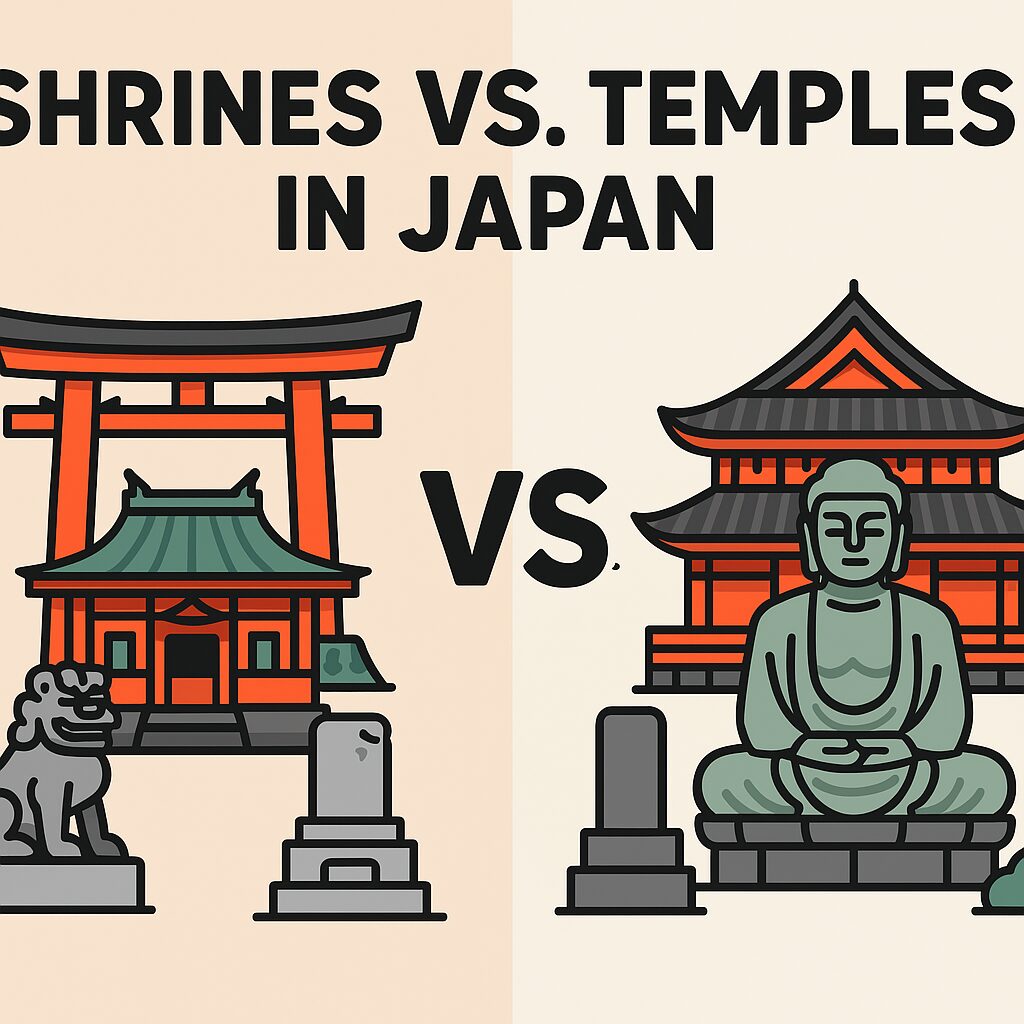To many Japanese people, Shinto shrines and Buddhist temples are familiar parts of daily life. But when a curious traveler or child asks, “What’s the difference?” even locals sometimes hesitate. Let’s explore the key distinctions and the complex history behind them.
⛩️ Religious Roots: Gods vs. Buddhas
Shrines (jinja) belong to Shinto, Japan’s indigenous religion, while temples (tera or oji) are associated with Buddhism, which came from India via China and Korea.
- Shrines enshrine “kami”, the Shinto deities. These can be mythological gods like Amaterasu, ancestral spirits such as Emperor Ōjin, natural elements like mountains and rivers, or even historical figures like Tokugawa Ieyasu or Sugawara no Michizane.
- Temples honor Buddhas, awakened beings such as Shakyamuni (the historical Buddha). Statues like Dainichi Nyorai or Amida Nyorai represent enlightened wisdom—not gods to worship but ideals to follow.
Over time, Shinto and Buddhism intertwined. A prime example is Hachiman Shrines, which honor Emperor Ōjin as a kami, later revered as the bodhisattva Hachiman Daibosatsu in Buddhism.
🏯 Visual Symbols: Torii, Statues, and Graves
Some landmarks help distinguish shrines and temples—but it’s not always that simple.
| Feature | Common at Shrines | Common at Temples |
| Torii Gate | ✅ | ❌ (but sometimes present) |
| Buddhist Statues | ❌ (rare) | ✅ |
| Graveyards | ❌ | ✅ |
| Purification Font | ✅ | ✅ (in some cases) |
Torii gates mark sacred entrances at shrines.- Buddhist temples often include graveyards and elaborate statues.
- Historically, mixed sites existed—and some shrines still feature Buddhist relics.
📜 Historical Overlap: Syncretism and Separation
Japan’s religious landscape is layered with centuries of fusion and division.
- In the Heian era, Shinbutsu shūgō blurred lines—kami were seen as manifestations of Buddhas.
- Under the Tokugawa shogunate, people were registered under temples for official records.
- In the Meiji period, the government enforced Shinbutsu bunri, separating Shinto from Buddhism—sparking iconoclasm like haibutsu kishaku, where Buddhist relics were destroyed.
Despite this, remnants of both traditions still intermingle in practice and belief.
🎎 Life Milestones: When Do People Visit Shrines or Temples?
Japanese people may not call themselves religious, but both shrines and temples mark life’s most significant moments.
| Occasion | Typically at a Shrine | Typically at a Temple |
| Baby blessings (Hatsumiyamairi) | ✅ | ❌ |
| Coming-of-age and longevity rites | ✅ | ❌ |
| Weddings (Shinto-style) | ✅ | ❌ |
| Funerals and memorials | ❌ | ✅ |
| Ancestor veneration (Obon, Higan) | ❌ | ✅ |
Shrines celebrate life and beginnings, while temples often accompany endings and remembrance. However, some weddings happen at temples and Shinto funerals (Shinsōsai) do exist—so it’s not always black and white.
🧭 Conclusion: Beyond What’s Different
Rather than focusing only on distinctions, understanding how shrines and temples have evolved together over centuries offers deeper insight. Whether you’re bowing before a Shinto kami or meditating in a temple hall, both are paths toward reflection, reverence, and cultural connection.



コメント